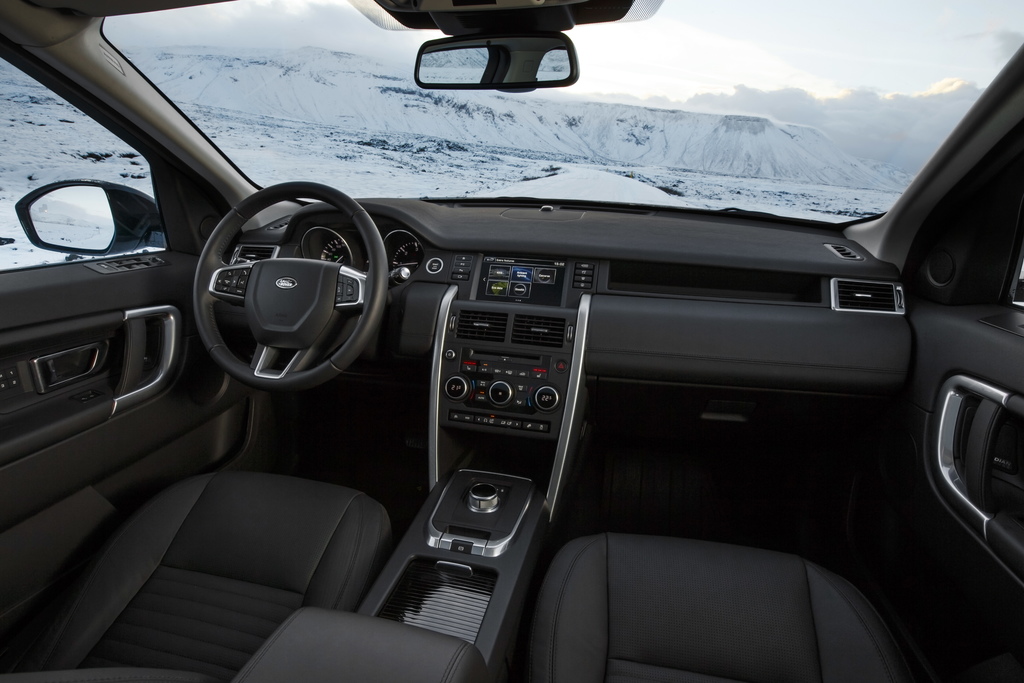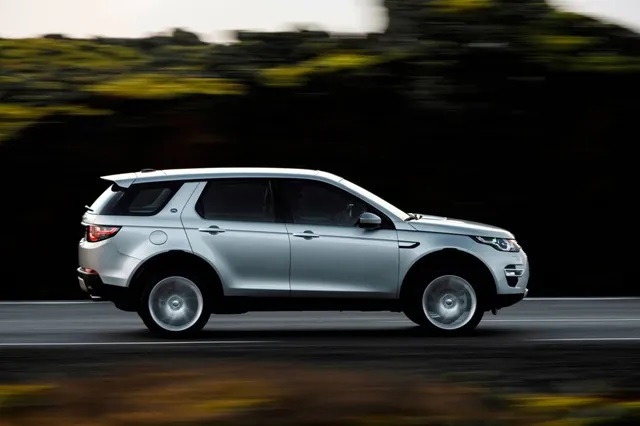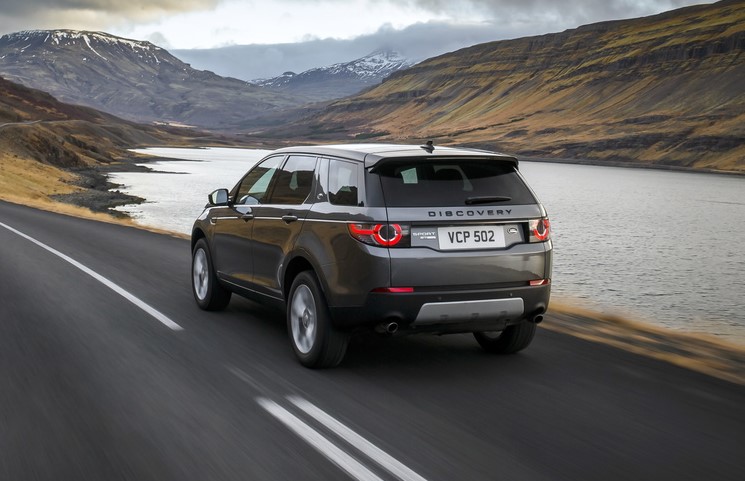
RAC sale – up to 33% off*
• Roadside cover from £5.29 a month†
• We get to most breakdowns in 60 mins or less
• Our patrols fix 4/5 breakdowns on the spot

Things you'll like
- Few premium rivals have seven seats
- True off-road capability
- Classy image and cabin
Things to consider
- Disappointing reliability reports
- Premium used price tag
- So-so performance and economy
History: What is the Land Rover Discovery Sport?
The Discovery Sport arrived in Land Rover’s range late in 2014 as a replacement for the much-loved Freelander – a car which spanned 18 years of production in just two generations. It sat alongside the smaller, less practical and more style-oriented Range Rover Evoque.
Replacing the Freelander was no mean feat, so Land Rover pulled out all the stops to make sure its new model cut it against a vastly growing collection of premium rivals – beyond the usual advancements in technology and drive refinement.
Despite borrowing its name from the Discovery – at the time one of Land Rover’s star nameplates – the Discovery Sport is significantly smaller, utilising the same basic platform as the Evoque. While being less than 10cm longer than the outgoing Freelander, the brand’s packaging gurus managed to cram seven seats inside.
While that extra row was really only usable by children, it gave the Discovery Sport a real unique selling point when pretty much every rival would only accommodate five people. Prior to its arrival a seven-seat SUV was a large, unwieldy thing with running costs to match.
The Disco Sport (as it was affectionately called) eventually inspired three-row alternatives such as the Skoda Kodiaq and Mercedes-Benz GLB. Neither of these cars had the Land Rover’s USP of peerless off-road ability, however.
Despite being one of the brand’s most road-biased models it gets its famed Terrain Response system and permanent four-wheel drive in most versions, giving it more mud-plugging ability than just about any rival.
But is the Discovery Sport a wise used buy a decade on from its launch? We’ll run through what you need to know in this used review.
Verdict: is the Land Rover Discovery Sport a good car?
Judged purely on its merits as a car a used Discovery Sport is an impressive package, combining family-friendly practicality, off-road capability, on-road refinement and a premium image in a relatively affordable package.
There are alternatives with a sharper driving experience, better performance and lower running costs. But the main drawback is the Discovery Sport’s patchy reliability. However, if you get a good one, it’s a strong family car.
Specs and used pricing
Land Rover made numerous changes to the Discovery Sport throughout its life, most significantly with the introduction of its in-house Ingenium engines in 2015, and then in late 2019 with a facelift that brought extensive upgrades under-the-skin. We’ll focus on the pre-facelift model here.
There were a variety of four-cylinder petrol and diesel engines offered for the pre-facelift model, with an impressive new three-cylinder plug-in hybrid (badged P300e) added in 2020 that became the default choice for company car drivers looking to save on Benefit-in-Kind. It’s also worth remembering that not all versions came with seven seats as standard.
Trim levels were a bit more confusing. For the early model things kicked off with base Pure trim (not a strong seller) which came with part leather, cruise control, an eight-inch touchscreen and rear parking sensors. More popular was SE, bringing dual-zone climate control, heated front seats and a heated windscreen.
SE Technology added sat-nav, an electric tailgate, auto lights and wipers and rear parking sensors, while HSE brought along full leather, a panoramic glass roof, xenons, a rear-view camera, bigger alloys and an upgraded sound system. HSE Luxury went to town with niceties such as automated parking tech, cooled front seats and heated rear seats, plus air-con controls for the third row.
The facelifted model offered similar kit levels (with some extra new tech bits), with S, SE and HSE trims. However, you could chose between standard and ‘R-Dynamic’ versions of each trim, adding sportier exterior bits to increase desirability.
At the time of writing (late 2024) prices for the Discovery Sport kick off at a tempting £8,000, although that’ll be for a low-spec model with over 100,000 miles. Most for sale use the Ingenium TD4 diesel engine, although a few using the old (and worth avoiding) Ford-sourced power units still feature.
Spend £10,000 and you'll get a 2016 HSE model with around 80,000 miles on the clock, but you’ll want a couple of grand more for a really good condition car with lower miles. You’ll need at least £15,000 for a modestly specced, high mileage 2019-on facelift model, but £20k will give you a much better choice of low mileage, high-spec models.
Rivals
Which rivals you consider alongside the Discovery Sport depends on your need for seven seats or not, bearing in mind plenty of them were sold with just five seats.
Five seat competitors with a similarly premium badge include the Mercedes-Benz GLC, BMW X3, Volvo XC60, Audi Q5 and Lexus NX. From within the Jaguar Land Rover (JLR) stable you might also want to include the Jaguar F-Pace and smaller, more stylish Range Rover Evoque as options.
If space for five children is a must, then we’d point you towards non-premium rivals such as the Skoda Kodiaq, Volkswagen Tiguan Allspace, Hyundai Santa Fe, Kia Sorento and Peugeot 5008.
Interior and practicality
Pre-facelift Discovery Sports hail from an era before touchscreen domination and haptic feedback controls. This means that it’s hardly minimalist, with lots of buttons scattered about, but logical to operate once you’ve found everything.
There’s a good sense of quality to most of the fixtures and fittings, although if you’re coming from a bigger Range Rover or Discovery you’ll notice where costs have been cut. It’s a more functional cabin than even the smaller Range Rover products – a deliberate choice to keep the pecking order – but there’s plenty of soft-touch finishes and classy details.
The eight-inch touchscreen wasn’t a highlight when the car was launched, but really feels its age now thanks to clunky responses and dated graphics. It’s made more functional thanks to the physical shortcut buttons surrounding it, at least, while you’ll be pleased to hear proper switchgear for the heating and ventilation functions remains. All models also get a full colour display between the dials.

Passenger space, storage and boot space
The Discovery Sport feels thoroughly modern when it comes to passenger space – at least in the front two rows where adults can enjoy plenty of headroom and (when the rear seats are slid and reclined all the way back) oodles of legroom. The middle seat is also more usable than some alternatives thanks to a small transmission tunnel.
Things are less impressive in the third row, if specified. Land Rover marketed the Sport as a 5+2 seater at launch rather than a full seven-seater, and it’s evident just from trying to squeeze into them from the rear doors that they’re designed with pre-teen kids in mind. Medium-sized adults could jam themselves in for a quick lift home from the pub, but it’s hardly a comfortable experience. A Kia Sorento is better suited to carrying seven adults.
Boot space with all seven seats up is just 194 litres, but it’s a doddle to drop the third row flat into the boot to give a large load space. The middle seats fold easily, too (some versions let you do this electrically via switches in the boot) while if you want to load long items but keep passengers there’s 40/20/40 split-folding.
Oddment storage is a real highlight of the Discovery Sport, too. There’s cupholders all over the place, big door bins front and rear, a good glovebox and a well-designed centre console that even incorporates a hidey-hole for valuables under the centre cupholder.
What is a used Land Rover Discovery Sport like to drive?
The Discovery Sport is no sports car by any stretch, but neither does it waft down the road is imperiously as the bigger Land Rovers. It strikes a reasonable balance between the two, but overall a BMW X3 is more accomplished on the road.
The Sport is at its best with the smaller wheel sizes available because the low-speed ride is surprisingly busy – possibly as a consequence of its off-road ability. On the biggest wheels it really can thump over about-town potholes, but in all versions the ride smooths out nicely the faster you go making it a really comfortable motorway cruiser.
The optional adaptive suspension improves things further, but it’s very hard to find one equipped with this secondhand. Handling-wise, it’s a confidence-inspiring car thanks to accurate steering and plenty of grip, even if there’s more body roll than in an X3 or F-Pace.
What the Discovery Sport does that those cars can’t is properly deliver off the beaten track. All but the cheapest eD4 diesel have permanent four-wheel drive and on all the key off-road traits (axle articulation, ground clearance, wading depth and approach and departure angles) it sets the standard for road-biased family SUVs. It’s a pity that the four-mode Terrain Response system doesn’t have a proper set-and-forget Auto mode like the bigger Land Rovers, however.
Engines
The overwhelming majority of used Discovery Sports you’ll find for sale have diesel engines mated to Land Rover’s nine-speed automatic gearbox. Although a six-speed manual was available – with less potential to generate expensive bills – it never really suited the car’s character. For the first six months or so of the Sport’s life the sole engine option was a 2.2-litre Ford-derived diesel borrowed from the outgoing Freelander.
Available in 150hp or 180hp forms and badged SD4, this was quite a gruff, raucous engine with adequate rather than generous performance, but enthusiasts now tend to favour these over the new Ingenium units for reliability.
Nevertheless, the Ingenium diesels greatly improved refinement. The entry-level 150hp eD4 (the only front-wheel drive Discovery Sport available) is best avoided as it’ll feel underpowered with a full-load, but the more 180hp TD4 is a good all-rounder, with ample performance for load-lugging. Those looking to regularly tow caravans will want the 240hp SD4 with its gutsy torque delivery and 2.2-tonne towing capacity.
When diesel fell out of favour with new buyers, Land Rover drafted in a pair of 2.0-litre Ingenium petrol engines from 2018. These are relatively rare on pre-facelift models, but with 240hp or 290hp they do offer an injection of performance missing from the lower-level diesels. They’re tough to recommend, however, thanks to their thirst for fuel and high tax costs.

Ownership, running costs and reliability
The early 2.2-litre diesel engines are notoriously thirsty relative to similar alternatives, with an official economy figure of 39.2mpg. The front-wheel drive Ingenium eD4 is the most efficient managing 49.6mpg, while the more powerful TD4 promises around 43mpg officially.
The Si4 petrols are hard to recommend with official figures as low as 26.7mpg. Pre-2017 versions also have higher tax costs than the diesels, but the 2017-on models benefit from a flat tax rate.
One issue potential owners will have to think about is the high potential for theft of Discovery Sports. The desirability, coupled with some security weaknesses, means DVLA data suggests it’s one of the most stolen cars in the UK. Insurance premiums reflect this, so investing in your own security measures can help bring these costs down.
Reliability is another big factor to consider, according to widely cited reports. Earlier models were reportedly prone to suffering from electrical glitches and rattles, while the Ingenium diesel engines have been known to suffer premature failures. We’d highly recommend investing in breakdown cover if you’re still interested.
We'd always be looking for full or extensive service history, particularly on an early Discovery Sport. Even items such as the car battery and brake discs can be expensive from Land Rover, so check these have plenty of life left in them.
Euro NCAP: is the Land Rover Discovery Sport a safe car?
The Land Rover Discovery Sport was one of the safest cars in its class at launch, with the maximum five-star safety rating from crash test experts Euro NCAP. A full nine airbags feature as standard including a pedestrian one below the windscreen, while automatic emergency braking is also fitted across the range. Interestingly, the Discovery Sport performed significantly better than its Range Rover Evoque sister car.
FAQs
Is the Land Rover Discovery Sport a luxury car?
The Land Rover Discovery Sport is a premium-badged family SUV, and it certainly has many of luxury touches. But is it classed as a luxury car? Well, Land Rover considers it the more functional alternative to the more style-focused Range Rover Evoque, so there are more luxurious models out there.
Is the Land Rover Discovery Sport reliable?
The Land Rover Discovery Sport has a somewhat patchy reliability record, making it a good idea to thoroughly check a used example and look at aftermarket warranty options. Reported problems range from electrical glitches to engine failure, so be sure you know what you’re getting into when shopping for one.
Is the Land Rover Discovery Sport expensive to maintain?
Putting reported reliability aside (which can simply be bad luck for some) the Discovery Sport should be more affordable to run than larger Land Rover products. It’s better on fuel and therefore cheaper to tax and run, while parts prices aren’t excessively high. Insurance premiums can be steep, however, because evidence suggests Land Rovers are often targeted by thieves.








